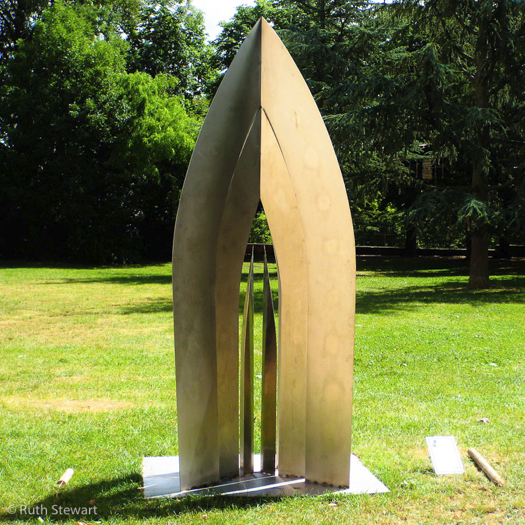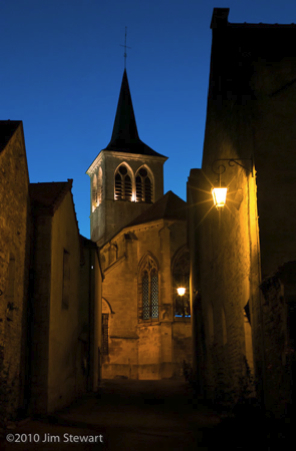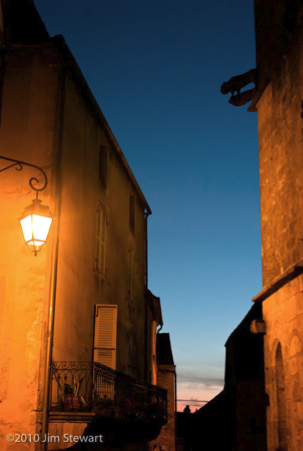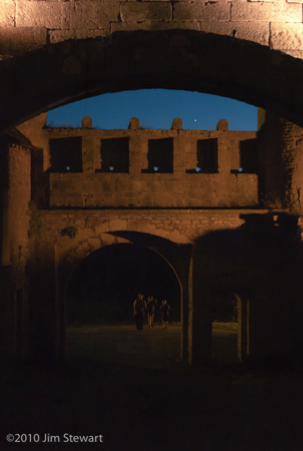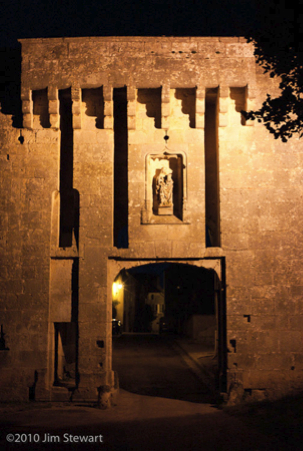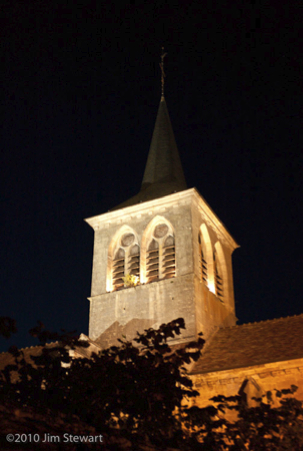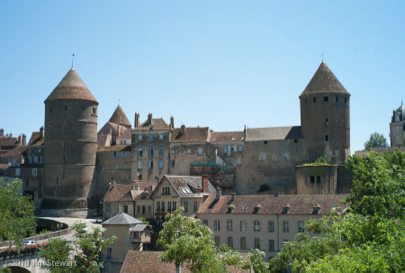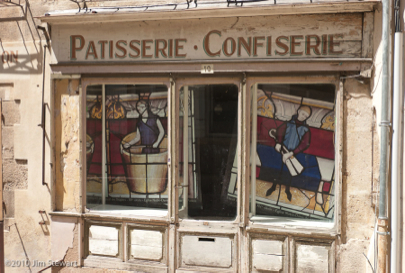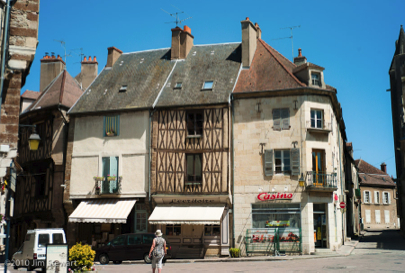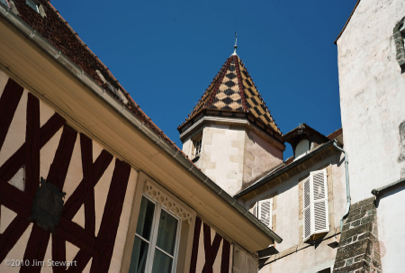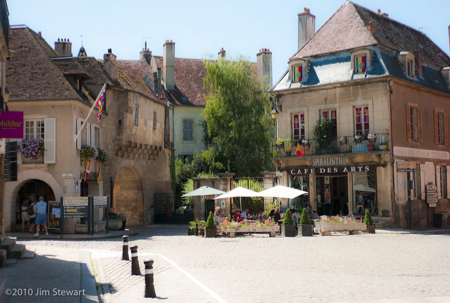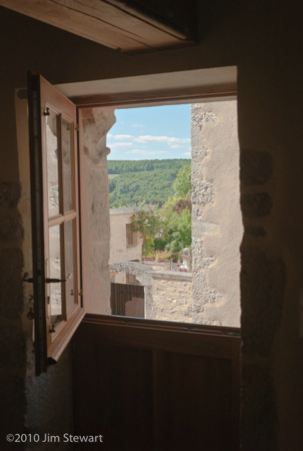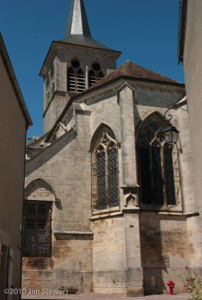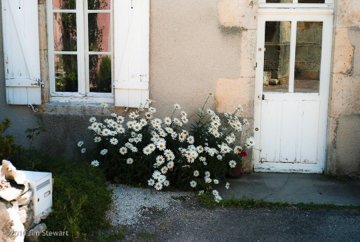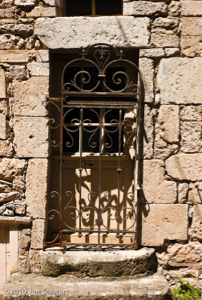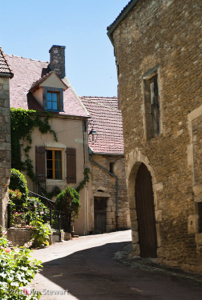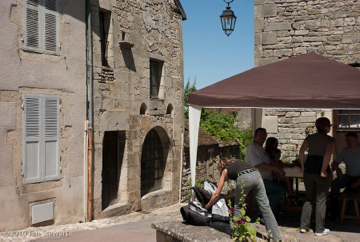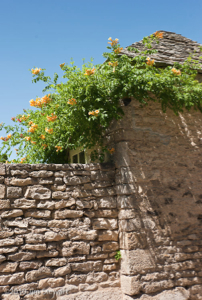Bourgogne
the day goes on...
23/07/10 20:42 Categorised as: Holidays | Summer 2010
storm clouds and downpours come and go
We stop for lunch in Chatillon-sut-Seine...
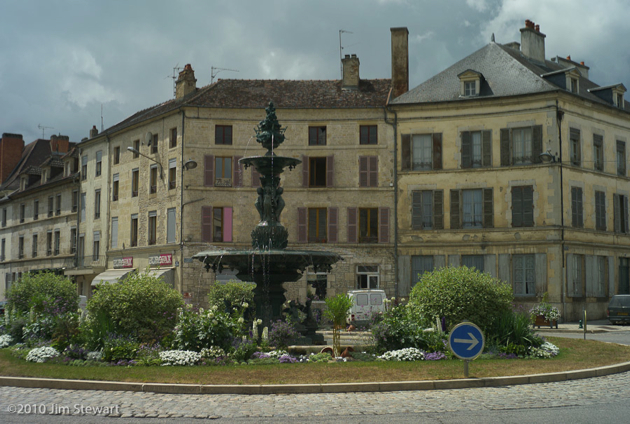
...drive a ways across the countryside in this most northerly part of the Département de la Côte d’Or, dodging downpours...
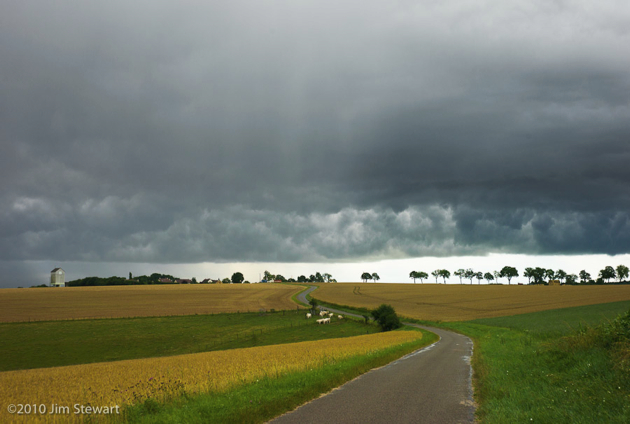
...and searching for Paris, and the source of the mighty River Seine.
Then all at once we’re there, at the veritable Source de la Seine...
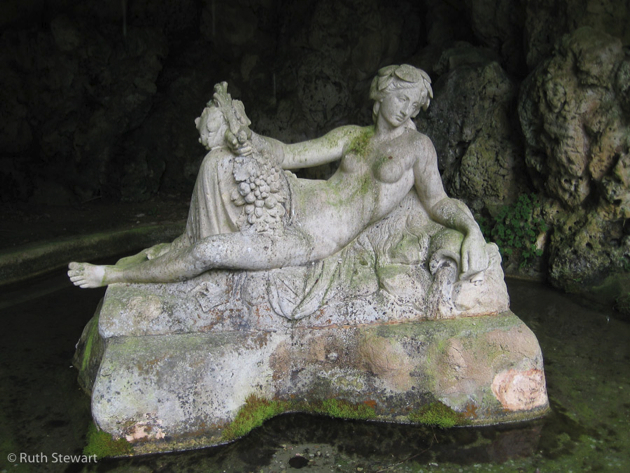
... where the goddess Sequana lolls atop the spring itself in a grotto. This is a little outpost of Paris, administratively as it is aesthetically, in the depths of the northern Côte d’Or, no more than about ten miles east of Flavigny.
In these pictures Ruth ambles across one of Paris’s least-known bridges, the Pont Paul Lamarche (1902-2003),
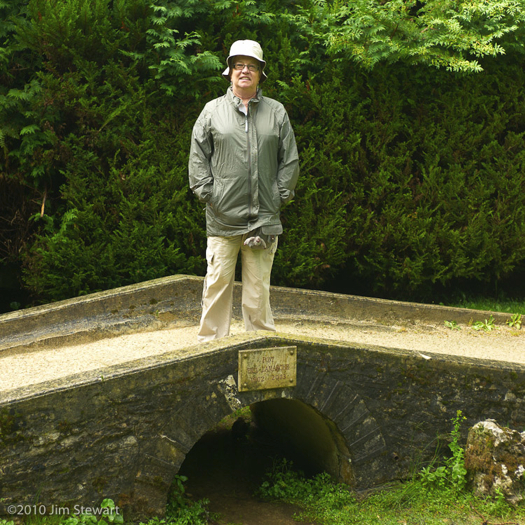
and poses alongside La Reine de la Seine herself, seemingly assisting her in her riparian endeavours!
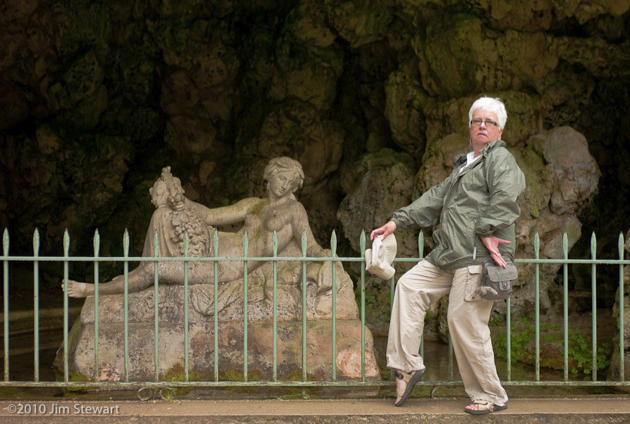
Then it’s back to Flavigny.
The sun finally breaks through over the town as we descend towards the Vignoble de Flavigny-Alésia in the valley below
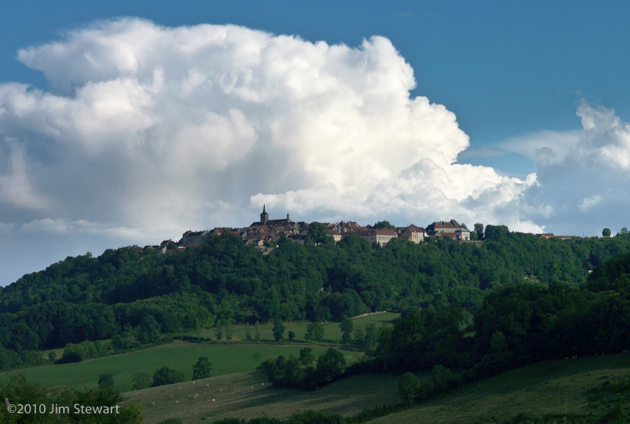
and repair to the Maison du Vigneron to break out a bottle of “Demoiselle de Laizan”, the Vignoble’s not-half-bad Vin Effervescent.
For we still have a birthday to celebrate!!!
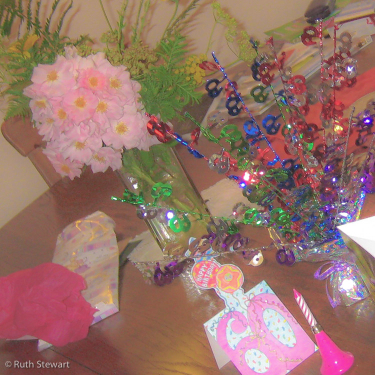
Comments
the day begins...
23/07/10 10:09 Categorised as: Holidays | Summer 2010
...with a birthday breakfast for a birthday girl
Never divulge that certain age, but it’s a big birthday!!!
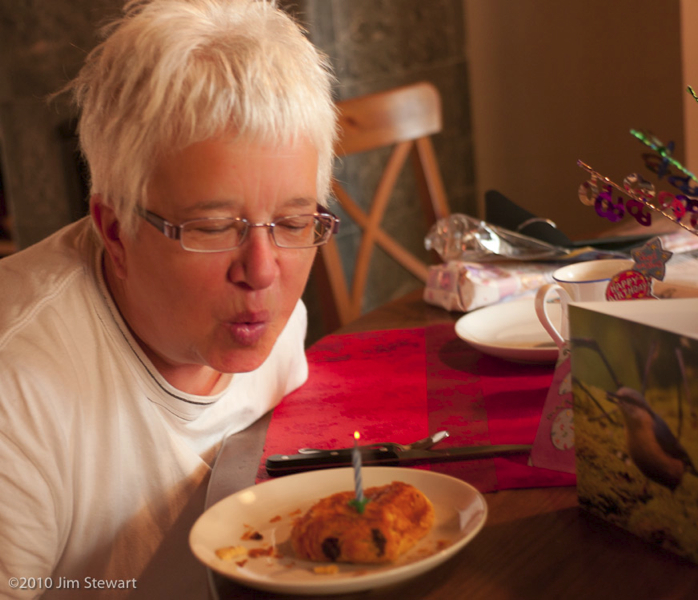
a rainy day in Flavigny
21/07/10 23:17 Categorised as: Holidays | Summer 2010
is an opportunity to explore indoors. Starting of course in the church.
And as we can, we start by going upstairs in the church
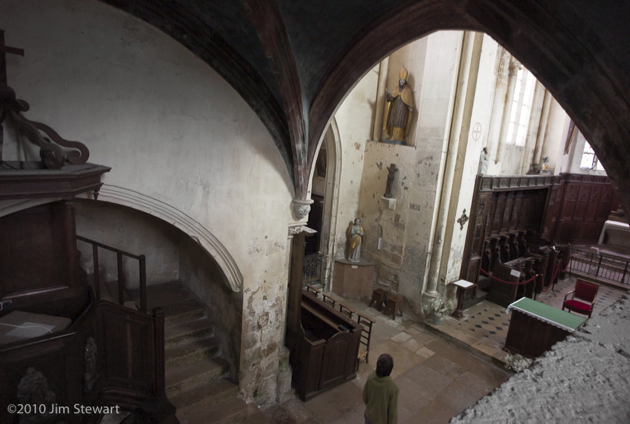
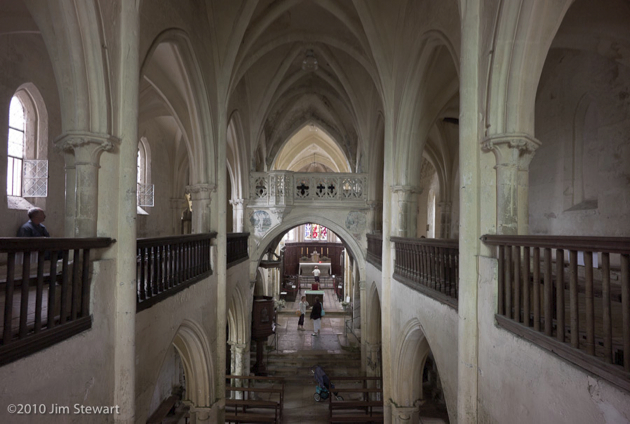
Downstairs, virgin and child appear
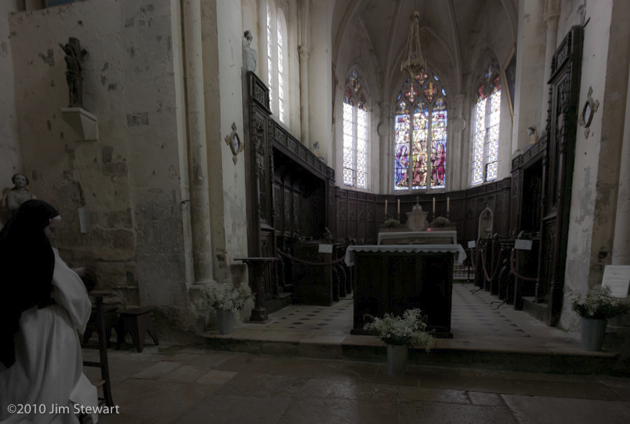
The weather does not improve, but there’s a wonderful stormy light in the sky, which deepens as the hours go by.
This is 4 o’clock:
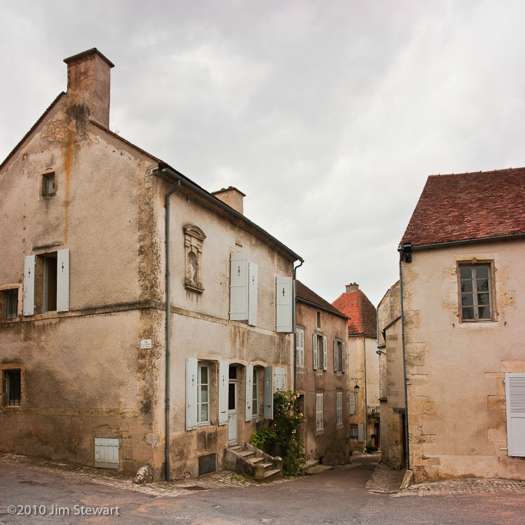
By 9pm the light is further enhanced by a rainbow, seen here over the roof of our neighbours’ house
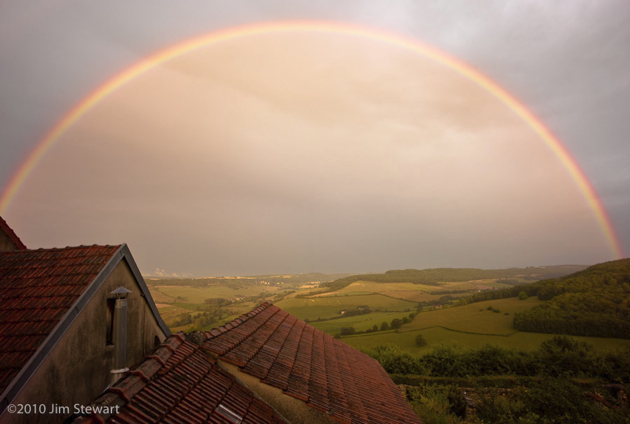
And as the light starts to fade, we walk back up to the church, still louring over the town as the sun sets over the hills
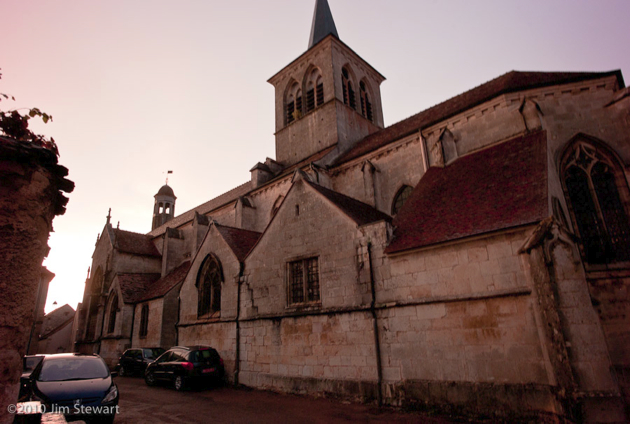
nighttime in Flavigny
20/07/10 18:31 Categorised as: Holidays | Summer 2010
around & about Flavigny (2)
19/07/10 18:31 Categorised as: Holidays | Summer 2010
around & about Flavigny (1)
18/07/10 13:31 Categorised as: Holidays | Summer 2010
to Flavigny-sur-Ozerain, and "La Maison du Vigneron"
17/07/10 17:53 Categorised as: Holidays | Summer 2010
if our 2010 holiday had a centre, this was it
After exploring some new parts of eastern central France, we headed today to our gîte in the village of Flavigny-sur-Ozerain, towards the north of the Côte d’Or Département in Burgundy. Is Burgundy the new Tuscany? Wait and see...
Not too far from Cluny to Flavigny, but we ambled along, checking out campsites at Beaune and Savigny-lès-Beaune for future reference along the way. The Beaune site (“100 Vignes”) looks to have potential, though we’re not sure how long we’d want to spend in the bustling wine town itself, and it’s a fairly urban site. Savigny - also not sure, though nearby Pernand-Vergelesses looked pretty, and would make a good centre for a slurping-tour of the Côtes.
First view of Flavigny was the best known (from pics on the web) view, across the valley from the N9 up from Pouillenay:
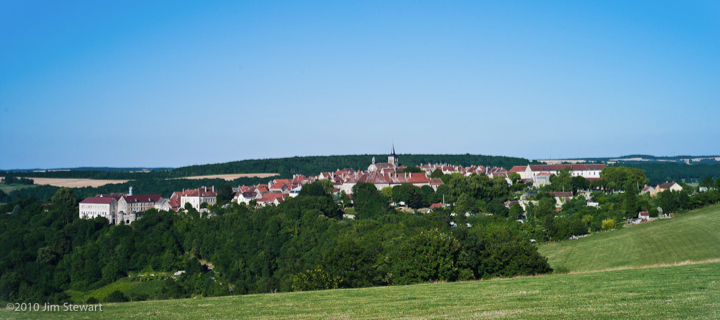
On arrival, a quick look round the village. All was pleasingly quiet - aside from the racket out of this wedding party. Can’t you just hear that confetti?
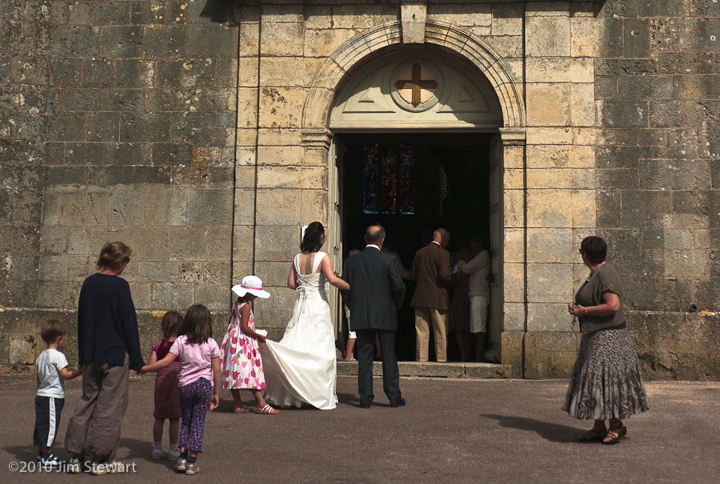
Cluny la Soirée : Rêves de Lumière & a "Scottish" Band
16/07/10 23:59 Categorised as: Holidays | Summer 2010
... back in town and we’re back for a second evening meal at the Brasserie du Nord
The sun is setting
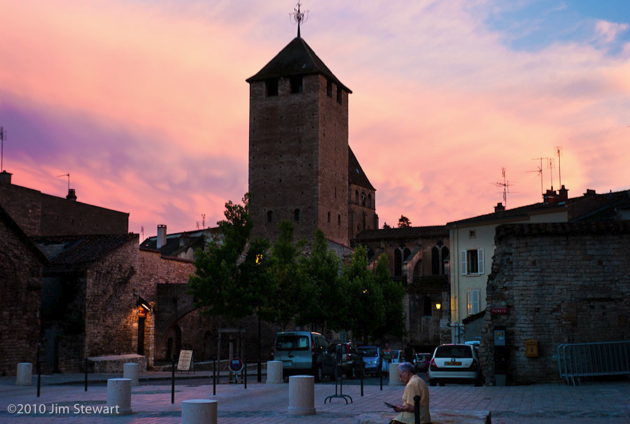
and a remarkable transformation is occurring before our eyes. A “Mise en Lumière” on the facade of the Palais du Pape Gélase, a part of the Cluny 2010 celebrations, and the work of the light artist Patrice Warrener and his Chromolithe Polychromatic Illumination System.
Here’s little .swf presentation of the development of the work:
Cluny2010(click to view - you’ll need to use your browser’s “Back” button to get back here)
Here’s the view from across the square:
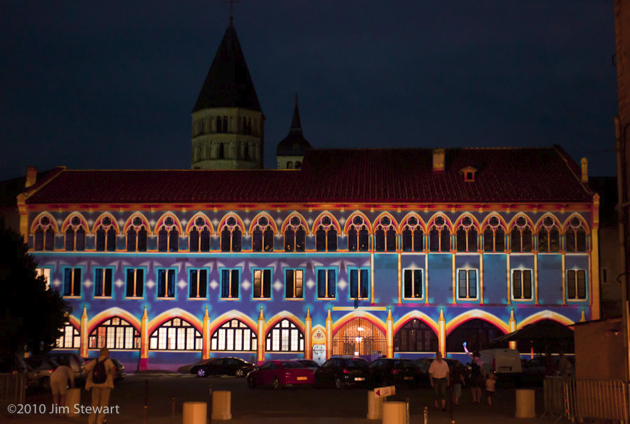
Picture of the night in the square, though, has to be this one from Ruth, of a little extra piece of the “Mise en Lumière” right on the terrace of the Brasserie du Nord
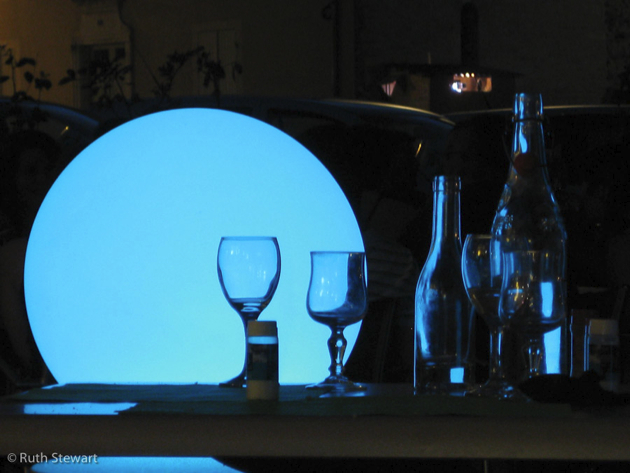
(The light in the background of this picture (top right) is the location of one of Warrener’s projection units, from which the “Rêves de Lumière” lights were beamed to the Palais’ facade)
So once we’d seen that, there was nothing for it but to hit the Café du Centre, to check out the “Celtic Scottish Music” band:
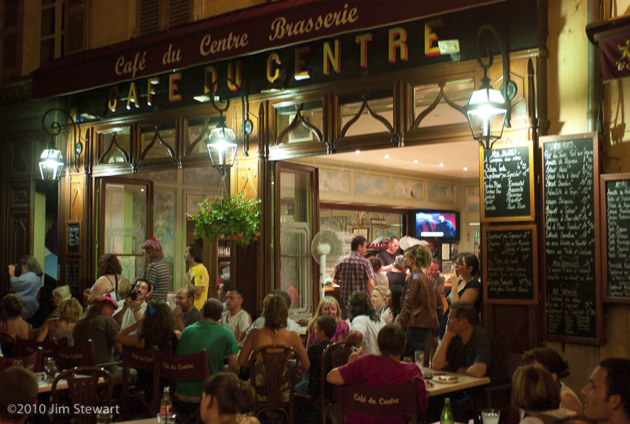
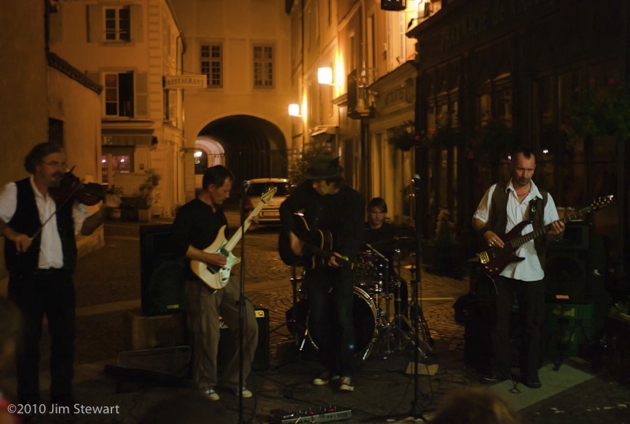
Then back to our hotel, for tomorrow we’re off to our gîte at Flavigny-sur-Ozerain
à Cormatin, et son Château
16/07/10 17:53 Categorised as: Holidays | Summer 2010
not far to the north of Cluny lies the village of Cormatin
There are two good reasons to visit Cormatin, and the less well-known is the excellent Caveau du Figuier, where - amongst the racks of Grands Crus de Bourgogne - we found a bottle of Figaro, a wine from the family Guibert of Mas de Daumas Gassac renown. We’d go back there!
Second, and best-known, is the Château de Cormatin, its owners including the Marquises of Huxelles, the powerful family du Blé, the Lacretelles, a branch of the Lamartine dynasty, and, at the turn of the 20th century, one Ralph Gunsbourg, Director of the Opéra de Monte-Carlo.
This is the Château...
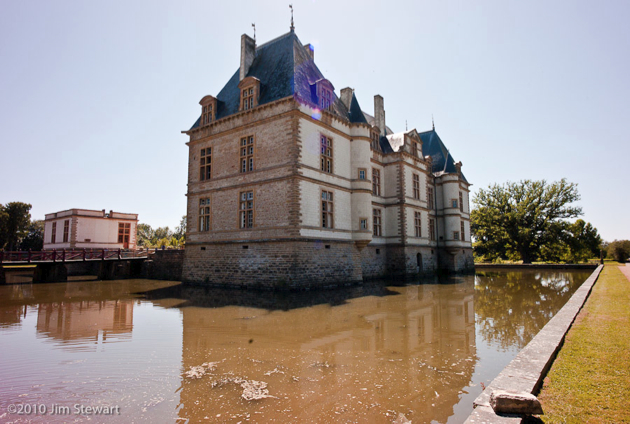
We took the tour...
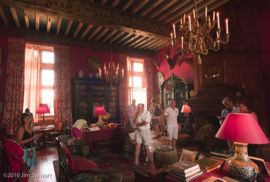
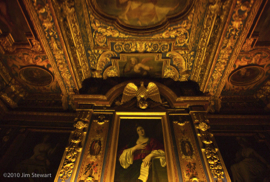
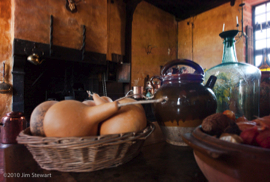
...and wandered in the grounds...
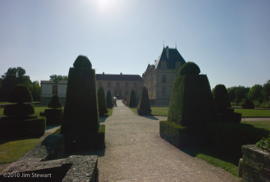
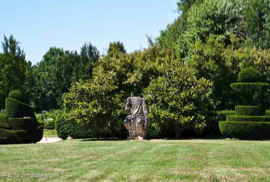
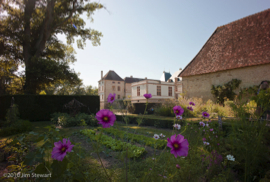
(As usual, click on a pic to enlarge)
afternoon ride : Cluny to Beaujolais
15/07/10 23:50 Categorised as: Holidays | Summer 2010
after lunch, a change of hotel
here’s the view from our new bedroom window:
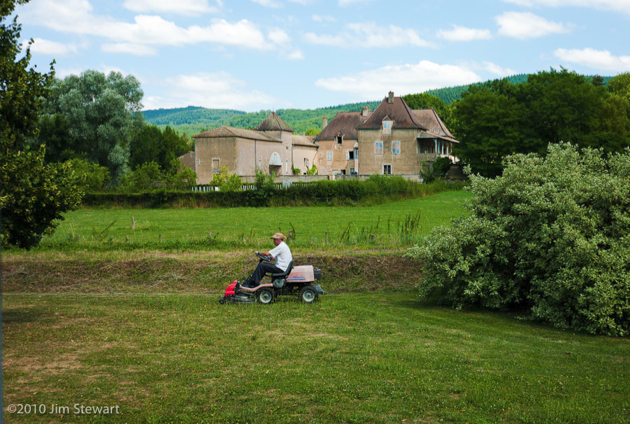
Then off south, stopping first in the hamlet of Saint Point, with its (inevitable) Église Romaine
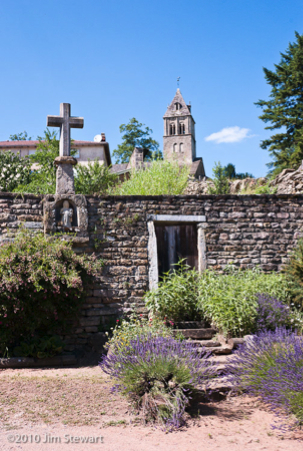
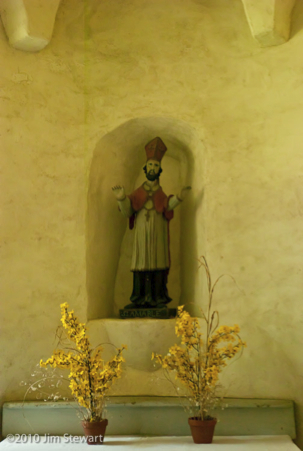
and the (privately owner-occupied) Château Lamartine, formerly eponymously owned & occupied:
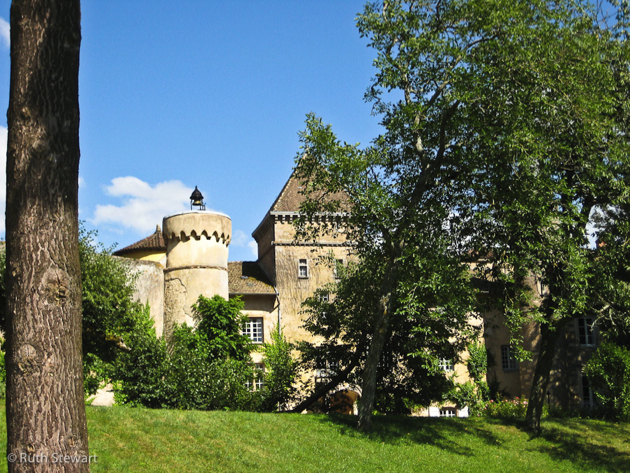
nice wee place, and a decent looking campsite nearby, so we may return!
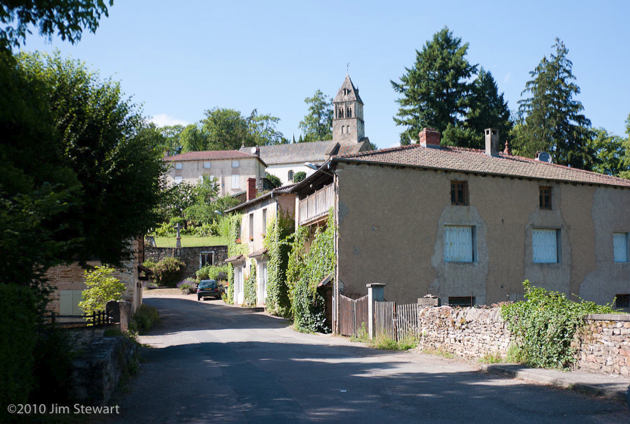
This next bit was a surprise. The posh vineyards of the Côte d’Or that we visited last trip were interesting, but less-opulent Beaujolais is actually far more scenically interesting, with far more dramatic slopes, and with some vineyards every bit as carefully-tended as anything we saw in Meursault or Vosne-Romanée (and some just as scruffy and neglected)
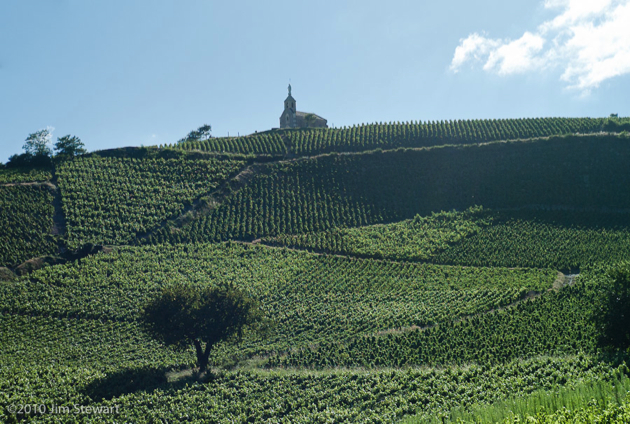
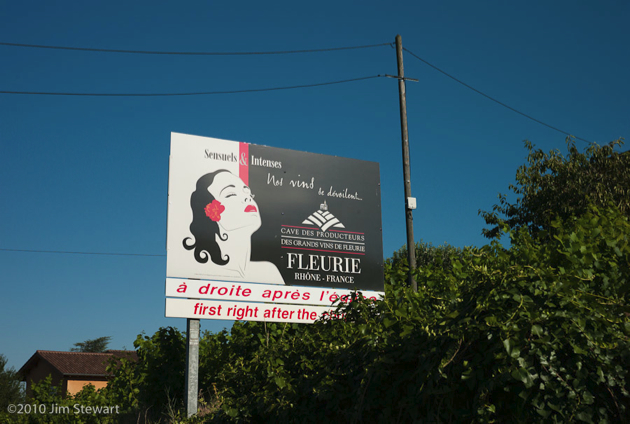
A nice style in promo here, too. She’s reminiscent of the graphic on the old Gitânes fag-packets you never seem to see in France anymore
à la Bourgogne
14/07/10 23:42 Categorised as: Holidays | Summer 2010
off now in search of some countryside that may be less dramatic than the Alps...
...but hopefully may be a little less mobbed. À la Bourgogne, and with a freshly purchased copy of “Bourgogne - Le Guide du Routard - 2010” to supplement (supplant?) the Rough Guide.
Interestingly, the Routard seems to confirm and to develop Jim’s long-held but never well-substantiated notion that France splits in two, climatically, across a line that passes about 50 miles south of Paris: with a Mediterranean climate to the south and a broadly British type of weather to the North thereof. Not only confirms what Jim thought he’d seen, but further amplifies the significance of the line, while relocating it to a point more like 150 miles south of Paris. The chapter on the Saône-et-Loire Département begins thus:
“Si vous avez pris l'autoroute pour rejoindre Mâcon depuis Dijon ou Beaune, l'apparition dans le lointain de villages aux toits de tuiles douces et rondes à la romaine, accompagnée dans l'air d'un changement de climat et d'atmosphère, d'une lumière soudain plus gaie, est un signe qui ne trompe pas : il vous indique, mieux qu'un panneau frontalier, le passage irrémédiable du <
Roughly translated, with the help (and despite the hindrance) of Google’s translator:
“If you take the highway out of Dijon or Beaune towards Mâcon, you may notice the appearance in the distance of villages with roofs of smooth and rounded Romanesque tiles; a “change in the air” of climate and atmosphere, and a light that is all at once more cheerful. These signs do not deceive. They indicate, more clearly than any frontier marker, the ineluctable passage from the North to the South, not only of Burgundy, but also of France.
“This frontier is architectural at first: at Tournus, steep roofs covered with slates or tiles flare flat, and spread out. They take on the colour of, and are covered with, the rounded tiles of Roman Provence.
“Then we cross a language frontier : in the north of the Mâconnais a line bounds the Franco-Provençal “langue d’oc” from the “langue d’oil” of the north. Thus for example, “mas”, the Southern word for rural housing, is replaced by “meix”, its Northern form.”
And today we two pass through Mâcon, pausing only to fill the tank in the baking midday heat of a deserted but automated supermarket forecourt. But we will be in Burgundy now for as far as we can really foresee, as this is Wednesday and on Saturday we have to be at Falvigny-sur-Ozerain, where our gîte will await and where we will stay for seven nights.
From Mâcon, our wanderings take us to Cluny, where we arrive just before the thunder, and grab a bed in a Logis. Full board - it doesn’t look like the rain will stop tonight. Strange encounter in the dining room that evening: pressed to order an aperitif, Jim plumped for a Campari soda. The waitress brought a glass of Campari and a bottle of Schweppes tonic water. When Jim questioned this, she informed him they had no soda, and anyway Campari with tonic is “meilleur”. Be warned, dear reader, it’s not! Jim drank what little he could, and it didn’t show up on the bill. So that was a’igh’n’e’end.
a morning in Cluny : the town with no Abbey
15/07/10 12:42 Categorised as: Holidays | Summer 2010
we didn’t really know what to expect of Cluny...
... the guides bang on about a ruined abbey, which to us Brit suggests something between a pile of rubble and the like of Fountains or Tintern.
The Abbaye de Cluny, renowned in its medieval day as the largest building in Christendom, was not destroyed by marauding armies. Out-sized only 500 years later by the upstart St Peter’s Basilica in Rome, before its decline and destruction, Cluny’s abbaye was a major force within European Catholicism. The Cluniac faction was dominant in the Benedictine order, shaping the political role of the church in medieval Europe and effectively running the papacy for a couple of centuries. (See wikipedia here)
The Abbaye’s decline appears to have its origins in serious financial mismanagement and overly-ambitious building programmes as far back as the 12th century. More recently in post-revolutionary France the last evidence of its former grandeur was pilfered down to its currently much-reduced size by local people in search of building materials.
The destruction of the abbey was completed by about 1850, just around the time when modern tourism could have made old Cluny into a major global destination, cf. the Alhambra, the Taj Mahal, Angkor Wat or the Vatican.
All that remains today are a few towers and steeples, but nevertheless Cluny is an attractive town which we enjoyed visiting, none the worse, and much the quieter, for not harbouring a “world class” tourist magnet!
We enjoyed our time in Cluny, and may very well return when next we hit Bourgogne. Good lunches at the Central Bar, and the beef with papardelle at the Brasserie du Nord deserves a mention.
We began our morning in Cluny not in the abbey (what abbey?) but in the church nearest to our hotel, the Église Saintt Marcel in the Rue Prudhon (yes, that Prudhon - he was from here too):
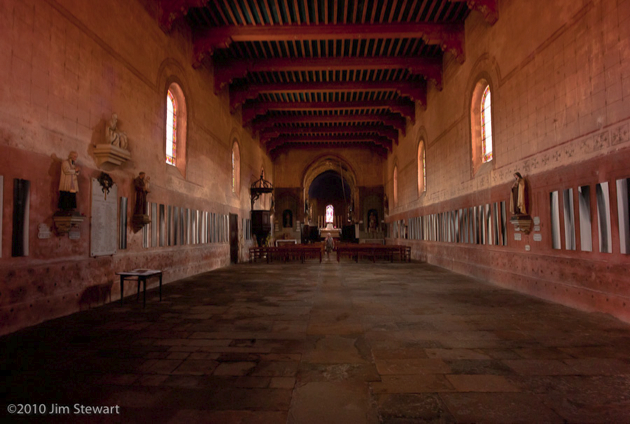
Thereafter, wandering the narrow streets and wide squares in Cluny’s centro storico, we were seldom more than a couple of minutes from some sighting of the (relatively) little that remains of the Abbaye. Round almost every corner there’s a glimpse of a tower...
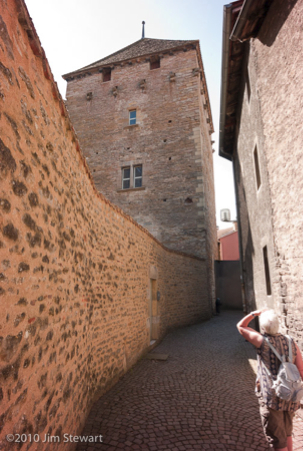
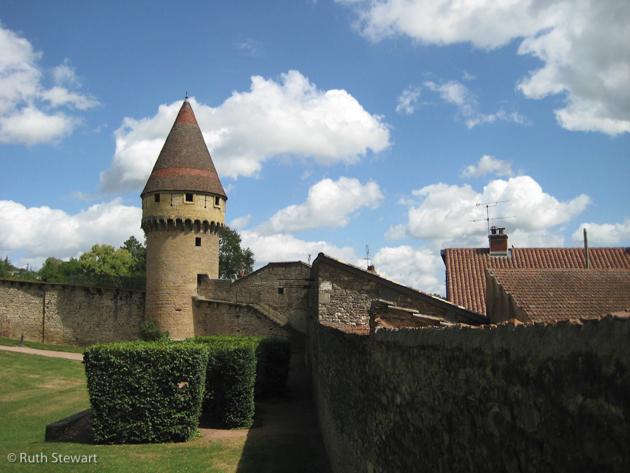
... or of the clocher of the ancienne Abbaye...
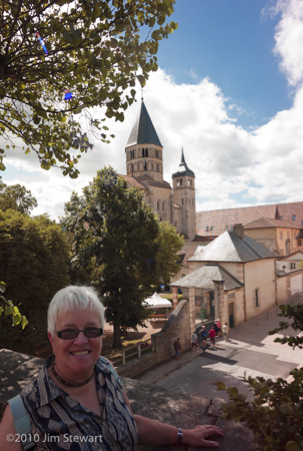
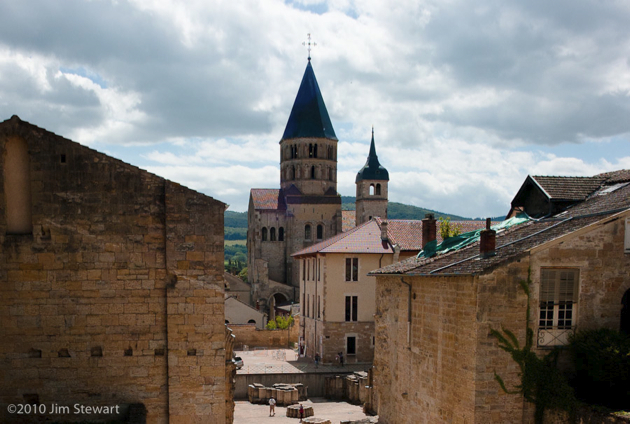
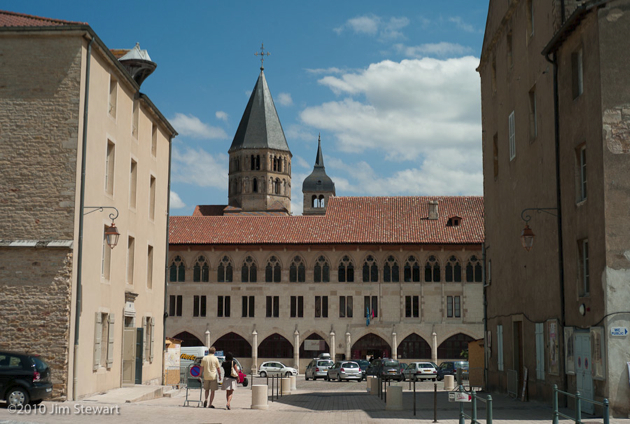
...though the town does have a contemporary cultural life today. The building at the centre of the above shot is a branch of the “École Nationale Supérieure d’Arts et Métiers”, and is this summer itself an artwork in the evenings (more on this tomorrow). Below is just one of a number of public sculptures which grace the town.
